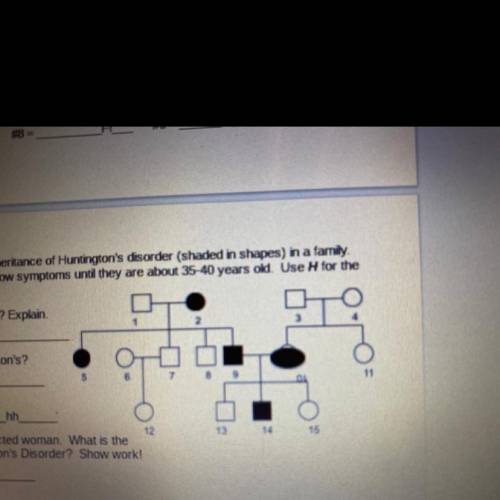
Biology, 23.04.2021 06:50 Legoman29305
The following pedigree follows the inheritance of Huntington's disorder (shaded in shapes) in a family.
People afflicted with Huntington's disorder do not show symptoms until they are about 35-40 years old. Use H for the
dominant allele and h for the recessive allele.


Answers: 3
Another question on Biology

Biology, 22.06.2019 00:00
Darrel conducted an experiment with the following procedure: fill two cups with ice water. place an uninflated balloon snuggly onto your left index finger. blow a little air into an identical balloon, and place it onto your right index finger. place both fingers into the cups of ice water. darrel noticed that his right finger felt warmer in the ice water than did his left finger. which of the following does the experiment show? a. air is a good radiator of heat. b. air is a good insulator of heat. c. air is a good conductor of heat. d. air is a good convector of heat.
Answers: 1

Biology, 22.06.2019 04:00
Will mark brainliest i only need the ! 1.use ten beads and a centromere of one color to construct the long chromosome. use ten beads and a centromere of a second color to construct the second chromosome in the long pair. make a drawing of the chromosomes in the space below. 2. for the second pair of chromosomes, use only five beads. 3. now model the replication of the chromosomes. make a drawing of your model in the space below. part b: meiosis i during meiosis i, the cell divides into two diploid daughter cells. 4. pair up the chromosomes to form tetrads. use the longer tetrad to model crossing-over. make a drawing of the tetrads in the space below. 5. line up the tetrads across the center of your “cell.” then model what happens to the chromosomes during anaphase i. 6. divide the cell into two daughter cells. use the space below to make a drawing of the result. part c: meiosis ii during meiosis ii, the daughter cells divide again. 7. line up the chromosomes at the center of the first cell, one above the other. separate the chromatids in each chromosome and move them to opposite sides of the cell. 8. repeat step 7 for the second cell. 9. divide each cell into two daughter cells. use the space below to make a drawing of the four haploid cells
Answers: 1

Biology, 22.06.2019 13:00
Dna, in the nucleus carries the genetic code for making proteins in ribosomes. in the diagram, b, represents the proteins produced. dna cannot leave the nucleus to carry the genetic information to the ribosome where proteins are produced. how does the genetic code get from the nucleus to the ribosome? what does a represent? now
Answers: 1

Biology, 22.06.2019 21:00
Me asap i need during photosynthesis, the following reaction takes place: carbon dioxide + water + light energy → sugar + oxygen during cellular respiration, the following reaction takes place: sugar + oxygen → carbon dioxide + water + chemical energy given this information, how are photosynthesis and cellular respiration related? question 2 options: a the products of photosynthesis are the reactants of cellular respiration. b photosynthesis and cellular respiration both start with the same materials. c photosynthesis and cellular respiration both produce the same materials. d the same type of energy is found in both photosynthesis and cellular respiration.
Answers: 1
You know the right answer?
The following pedigree follows the inheritance of Huntington's disorder (shaded in shapes) in a fami...
Questions

Chemistry, 31.03.2021 21:50

Mathematics, 31.03.2021 21:50

Mathematics, 31.03.2021 21:50

Mathematics, 31.03.2021 21:50


Mathematics, 31.03.2021 21:50

Health, 31.03.2021 21:50


Mathematics, 31.03.2021 21:50

History, 31.03.2021 21:50

SAT, 31.03.2021 21:50

English, 31.03.2021 21:50

Spanish, 31.03.2021 21:50

Mathematics, 31.03.2021 21:50

Social Studies, 31.03.2021 21:50



Mathematics, 31.03.2021 21:50

History, 31.03.2021 21:50

Mathematics, 31.03.2021 21:50



